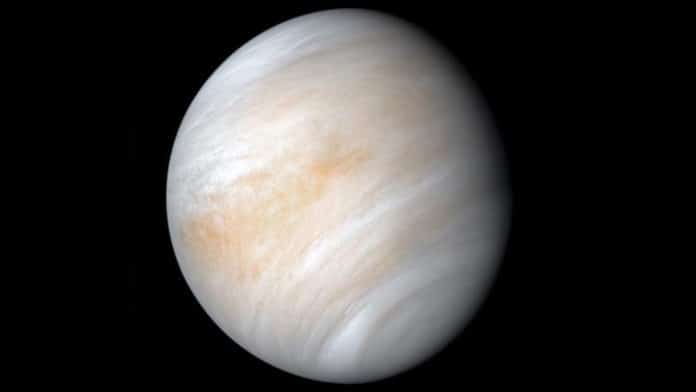Scientists have spent the past two years explaining the weird sulfur chemistry seen in the clouds of Venus. They have been studying whether there’s a way to make life a potential explanation for what is observed.
Using a combination of atmospheric and biochemical models, scientists from the University of Cambridge tested the ‘life in the clouds’ hypothesis and found that life cannot explain the composition of the Venusian atmosphere.
Scientists found that the study suggests that the unusual behavior of sulfur in Venus’ atmosphere cannot be explained by an ‘aerial’ form of extra-terrestrial life.
Any life form in sufficient abundance is expected to leave chemical fingerprints on a planet’s atmosphere as it consumes food and expels waste. However, scientists found no evidence of these fingerprints on Venus.
Even if Venus is devoid of life, the study could be useful for studying the atmospheres of similar planets throughout the galaxy and the eventual detection of life outside our Solar System.
Co-author Dr. Paul Rimmer from Cambridge’s Department of Earth Sciences said, “We’ve spent the past two years trying to explain the weird sulfur chemistry we see in the clouds of Venus. Life is pretty good at weird chemistry, so we’ve been studying whether there’s a way to make life a potential explanation for what we see.”
Sean Jordan from Cambridge’s Institute of Astronomy, the paper’s first author, said, “We looked at the sulfur-based ‘food’ available in the Venusian atmosphere – it’s not anything you or I would want to eat, but it is the main available energy source. If that food is consumed by life, we should see evidence of that through specific chemicals being lost and gained in the atmosphere.”
Scientists mainly observed the abundance of sulfur dioxide (SO2) in the Venusian atmosphere. On Earth, most SO2 in the atmosphere comes from volcanic emissions. On Venus, there are large quantities of SO2 lower in the clouds, but it somehow gets ‘sucked out of the atmosphere at higher elevations.
Co-author Dr. Oliver Shorttle from Cambridge’s Department of Earth Sciences and Institute of Astronomy said, “If life is present, it must be affecting the atmospheric chemistry. Could life be why SO2 levels on Venus get reduced so much?”
In their study, scientists used models that include a list of metabolic reactions that the life forms would carry out to get their ‘food’ and the waste by-products. Using the models, they determined if these metabolic reactions could explain the reduction in SO2 levels.
They found that the metabolic reactions can result in a drop in SO2 levels, but only by producing other molecules in very large amounts that aren’t seen. The results limit how much life could exist on Venus without blowing apart our understanding of how chemical reactions work in planetary atmospheres.
Jordan said, “If life were responsible for the SO2 levels we see on Venus, it would also break everything we know about Venus’s atmospheric chemistry. We wanted life to be a potential explanation, but it wasn’t a viable solution when we ran the models. But if life isn’t responsible for what we see on Venus, it’s still a problem to be solved – there’s lots of strange chemistry to follow up on.”
Scientists found no evidence of sulfur-eating life in the clouds of Venus. Yet, they believe this study will be valuable when JWST, the successor to the Hubble Telescope, begins returning images of other planetary systems later this year. Some of the sulfur molecules in the current study are easy to see with JWST, so learning more about the chemical behavior of our next-door neighbor could help scientists figure out similar planets across the galaxy.
Shortly said, “To understand why some planets are alive, we must understand why other planets are dead. If life somehow managed to sneak into the Venusian clouds, it would change how we search for chemical signs of life on other planets.”
Rimmer said, “Even if ‘our’ Venus is dead, it’s possible that Venus-like planets in other systems could host life. We can take what we’ve learned here and apply it to exoplanetary systems – this is just the beginning.”
Journal Reference:
- Jordan, S., Shorttle, O. & Rimmer, P.B. Proposed energy-metabolisms cannot explain the atmospheric chemistry of Venus. Nat Commun 13, 3274 (2022). DOI: 10.1038/s41467-022-30804-8
